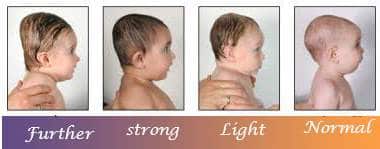

#Abnormal head shapes how to
The most common treatment is provided by the physiotherapist who will encourage active movement, and teach parents how to position their baby and do exercises with them to help improve the head shape.Ī very small number of babies with plagiocephaly (less than one in 10) have a severe and persistent deformity, and they may need to be treated with helmet therapy.Ī lightweight helmet is made by an orthotist using 3D images and fitted for your baby. If treatment is necessary, you may be referred to a specialist clinic where your baby will be treated by a team that may include a paediatrician, plastic surgeon, physiotherapist and orthotist. From the age of two weeks, while you are supporting their head in your hands, your baby can slowly follow your eyes or voice around, even if one way seems harder at first. The plagiocephaly will get better if you encourage your baby to turn their head themselves when they are awake. Plagiocephaly usually improves naturally as your baby grows and gains head control and can move their head by Most babies with deformational plagiocephaly do not need any treatment at all, especially if they are active and you have plenty of one-on-one interaction with them. If you have concerns about your baby's head shape or if you notice that your baby only turns their head to one side when lying on their back, see your Maternal and Child Health Nurse or GP. use a sling, hold them upright for cuddles, carry them over your arm on their tummy or side.

In different positions to encourage your baby to turn their head both ways. Place rattles or toys (or other people’s faces) that your baby likes to look at Play time: When your baby is awake and alert, play or interact with them facing you (face time) or place them lying down on their front (tummy time) or on their side from as early as one or two weeks of age.
#Abnormal head shapes windows
Babies often like to look at fixed objects like windows or wall murals, so changing their cot position will encourage them to look at things that interest them from different angles. Place your baby at alternate ends of the cot to sleep, or change the position of the cot Alternate your baby’s head position when they sleep. Head and cot position for sleep: A young baby will generally stay in the position they are placed for sleep, until they can move themselves.Do not use pillows in the cot for positioning. Sleeping position: Your baby must always be placed on their back to sleep to reduce the risk of SIDS (Sudden Infant Death Syndrome or Cot Death).Sometimes a flat spot develops when a baby has limited neck movement and prefers resting their head in one particular position.Ī baby's head position needs to be varied during sleep and when they are awake to avoid them developing deformational plagiocephaly. Sometimes a baby's head does not return to a normal shape, or they may have developed a flattened spot at the back or side of their head. The unusual shape, most babies' heads should go back to a normal shape within about six weeks after birth. This can be either related to their position in the uterus during pregnancy, or caused by moulding (changing shape) during labour, including changes caused by instruments used during delivery. It is quite common for a newborn baby to have an unusually shaped head.

This is called synostotic plagiocephaly, and is not addressed in this fact sheet. There is another type of plagiocephaly caused by abnormal closure of the skull bones. The skull, this is called brachycephaly ( brak-ee-kef-a-lee). When the head has a flat spot at the back of Flattening of the head in one area may happen if a baby lies with their head in the same position for a long time. Plagiocephaly occurs because the bones of a newborn baby's head are thin and flexible, so the head is soft and may change shape easily. Plagiocephaly does not usually affect the development of a baby'sīrain, but if left untreated it may change their physical appearance by causing uneven growth of their face and head. Plagiocephaly ( play-gee-oh-kef-a-lee) is a very common craniofacial (skull and face) problem. Deformational plagiocephaly, also known as positional plagiocephaly, means a misshapen, flat or asymmetrical (uneven) head shape.


 0 kommentar(er)
0 kommentar(er)
